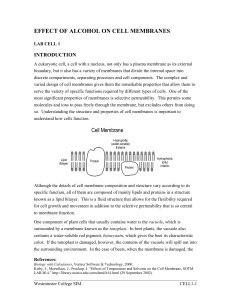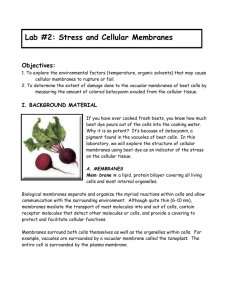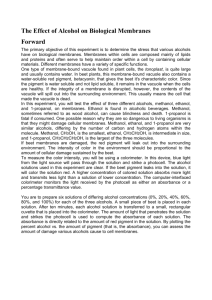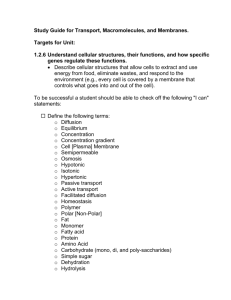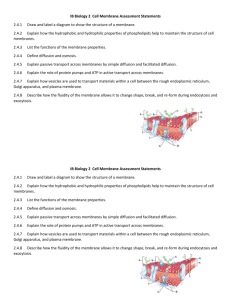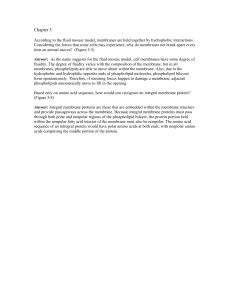iii. methods
advertisement
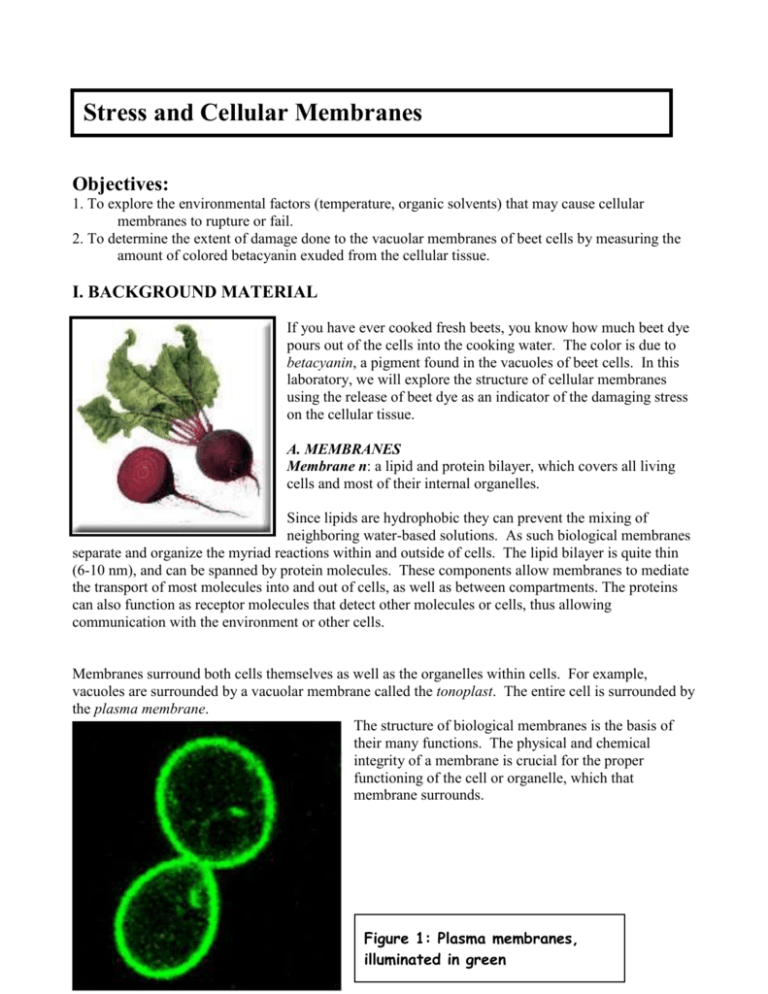
Stress and Cellular Membranes Objectives: 1. To explore the environmental factors (temperature, organic solvents) that may cause cellular membranes to rupture or fail. 2. To determine the extent of damage done to the vacuolar membranes of beet cells by measuring the amount of colored betacyanin exuded from the cellular tissue. I. BACKGROUND MATERIAL If you have ever cooked fresh beets, you know how much beet dye pours out of the cells into the cooking water. The color is due to betacyanin, a pigment found in the vacuoles of beet cells. In this laboratory, we will explore the structure of cellular membranes using the release of beet dye as an indicator of the damaging stress on the cellular tissue. A. MEMBRANES Membrane n: a lipid and protein bilayer, which covers all living cells and most of their internal organelles. Since lipids are hydrophobic they can prevent the mixing of neighboring water-based solutions. As such biological membranes separate and organize the myriad reactions within and outside of cells. The lipid bilayer is quite thin (6-10 nm), and can be spanned by protein molecules. These components allow membranes to mediate the transport of most molecules into and out of cells, as well as between compartments. The proteins can also function as receptor molecules that detect other molecules or cells, thus allowing communication with the environment or other cells. Membranes surround both cells themselves as well as the organelles within cells. For example, vacuoles are surrounded by a vacuolar membrane called the tonoplast. The entire cell is surrounded by the plasma membrane. The structure of biological membranes is the basis of their many functions. The physical and chemical integrity of a membrane is crucial for the proper functioning of the cell or organelle, which that membrane surrounds. Figure 1: Plasma membranes, illuminated in green Certain treatments can stress and damage the cell’s membranes. High temperatures cause violent molecular collisions that can physically destroy a membrane, whereas freezing causes water to crystallize as ice and expand because of the alignment of hydrogen bonds. This pushes membrane components apart often rupturing membranes. Application of physical stress, such as cutting, can also rupture membranes. Organic solvents dissolve a membrane’s lipids, in effect reducing the membrane to tatters. REFER TO YOUR TEXT FOR FURTHER INFORMATION CONCERNING ORGANIC MOLECULES (SOLVENTS), LIPIDS AND MEMBRANE STRUCTURE. B. BEET CELLS AND BETACYANIN Beet tissue will be your model to investigate membrane integrity. Roots of beet (Beta vulgaris) contain large amounts of a water-soluble reddish pigment called betacyanin, which is localized almost entirely in the large central vacuoles of cells. In intact, undamaged cells, betacyanin remains inside the vacuole, not being able to pass through the tonoplast (vacuole membrane). Sources of stress can cause betacyanin to leak through both the tonoplast and plasma membrane. This leakage will produce a red color in the water surrounding the stressed beet cells. The amount of leakage can be related to the degree of membrane damage. As a result the degree of damage can be directly related to the intensity of the color that appears in the surrounding solution. Further the intensity of the color can be quantitatively assessed using an instrument known as a spectrophotometer. C. SPECTROPHOTOMETRY Spec·tro·pho·tom·e·ter n: An instrument used to measure the relative intensities of light wavelengths in a spectrum. Spectrophotometry is based on the principle that some substances absorb light of a particular wavelength better than of another wavelength. Each substance has an “absorption signature,” where it absorbs a certain amount of one wavelength of light, a different amount (more or less) of a second wavelength of light, none of a third, and so on. This property can actually be used to identify different chemicals in an unknown sample. A spectrophotometer projects a beam of light of a particular wavelength through a solution contained in a cuvette, a test tube made of optically clear glass or plastic. The solution will absorb some of the light, and the amount absorbed is proportional to the quantity of absorbing substance present in the cuvette. This proportionality is called the Beer-Lambert Law: A = Elc The Beer-Lambert Law states the absorbance (A) of light is proportional to the length of the light path (l) times the concentration (c) of the substance. The molar extinction coefficient (E, epsilon) is also included. Different substances absorb different amounts of a particular wavelength of light and therefore have different E values. Note, here, that there is a linear relationship between absorbance and concentration. Figure 2: The path of light through the spectrophotometer. Note that the prism can be rotated, allowing light of different wavelength to shine through the test substance. The “spec” is a very delicate instrument. When using a spec, please be careful and ask your TA if you encounter any difficulties. Often, you may think that a button is unresponsive when in fact the spec is working appropriately. As with any delicate machine, using it well takes practice. Remember that the spectrophotometer has to be “blanked” each time the wavelength dial is changed In summary: Allow spec to warm up for 30 minutes before use. 1. Press A (from A/T/C) for “Absorbance”. Mode appears on display. 2. Press nm or nm to select wavelength. 3. Insert cuvette filled with the blank solution into cell holder and close sample door. 4. Press 0 ABS/100% T to set blank to 0A. 5. Remove blank and insert cuvette sample into cell holder. Measurement appears on LCD display. II. A CONTEXT FOR THE EXERCISE Recall the steps in Scientific Process: 1. Make observations about the natural world. 2. Ask questions about, or formulate a reasonable testable hypothesis to explain observations. 3. Design and execute, experiments to generate results, which could answer the question or test the hypothesis. 4. Analyze results and draw inferences regarding the veracity of the hypothesis and, if true, how it might fit with “established” knowledge. You should keep those steps in mind as you approach the analysis of any laboratory exercise. In the present case we might consider: Observation: Living tissue often dies when exposed to physical or chemical stressors. Our background, the text and other sources could inform you of what some of these stressors are, and provide suggestions as to how they work. Question: Here, you might ask such things as; does an increasing amount of a chemical stressor or degree of a physical stressor lead to greater damage of beet tissue (Beta vulgaris)? You could then formulate a more specific question by using a particular stressor e.g. temperature. Hypotheses: Here, by reference to background information, and/or your own creativity, you propose a mechanism for stressor action – here, likely membrane damage, and state it in a testable fashion e.g. 1. Membrane damage increases as temperatures become more divergent from ambient (room) temperature; this should result in increased release of betacyanin (a prediction). 2. Because cellular membranes are non-polar, more damage will be caused by solvents that are increasingly non-polar. Experiment: In normal circumstances the experimenter designs this “from scratch”. In these labs we provide you with a general format to guide your studies. You will use spectrophotometry to test your hypotheses. Betacyanin concentration in extracellular fluid will be used as the measure of membrane damage. See methods, section III. Results: Record your results in self-explanatory tables and graphs. Do your results differ from/agree with your classmates or with the “expected” result? What inferences can you make from your own results or from compiled results. III. METHODS Work in groups of four or as directed by your TA. A. Preparation 1. Prepare nine uniform beet cores using a cork borer with an 8 mm inside diameter, and trim each core to 15 mm in length. Four of these cores will be used for the temperature-related treatments, and five will be used for the solvent treatments. 2. Place cores in a beaker and rinse with room temperature tap water for 2 minutes to remove betacyanin that has leaked from damaged (cut) cells. 3. Place one core in each of nine capped vials labeled appropriately. B. Temperature-related treatments 1. Place a test tube in the ice bath (0° C) several minutes before you add the beet core so it is at the correct temperature. Once you add the core, keep it in the cold treatment for 30 minutes. 2. While the cold tube is incubating, start the hot treatments. For each of the 3 hot treatments (20° C, 60° C and 100° C) remove the beet core from its vial, and place it in a separate beaker of water at appropriate temperature. 3. Keep each core in the individual hot treatment beakers for 1 minute. 4. Remove each beet core from the treatment beaker in the hot baths carefully with forceps, being sure not to squeeze the core. Return the beet cores to their respective vials, and add 20 ml room temperature tap water to each tube. 5. After 30 minutes, remove the beet core from the cold-treatment tube, place it in the appropriate vial, and add 20 ml of room temperature tap water. 6. Keep all four temperature-treatment beet cores in their appropriate vials for 20 minutes, allowing any betacyanin to leak out into the water. Gently swirl each vial occasionally. 7. Quantify the amount of leaked betacyanin for each treatment by filling a cuvette with the solution, and using the spectrophotometer to measure the absorbance at 460 nm, the wavelength at which betacyanin absorbance is the highest. Make sure to calibrate or “blank the spec” first with a cuvette of tap water by pressing the button marked 0 ABS/100%T. 8. List your results in a neat, legible table, and graph your results with temperature as the independent variable on the x-axis and absorbance as the dependent variable on the y-axis. B. Solvent-related treatments 1. Using the remaining five vials with beet cores, add 20 ml of the following solutions of solvents to each vial: Tap water 25% acetone 50% acetone 25% Isopropanol 50% Isopropanol 2. Cap each vial, and keep them at room temperature for 20 minutes. Gently swirl each vial occasionally. 3. After 20 minutes, remove each core from its treatment. 4. Again, quantify your results for each treatment by placing a cuvette of each solution in a spectrophotometer and measuring absorbance at 460 nm. For measurements of solutions of acetone and Isopropanol, you will still “blank the spec” using tap water first. 5. List your results in a clear, legible table, and graph your results with solvent concentrations as the independent variable on the x-axis and absorbance as the dependant variable on the y-axis. IV. THOUGHT QUESTIONS 1. Compare you results to other lab groups. Do your individual results support or fail to support your hypothesis? Do the compiled results support or fail to support the hypotheses concerning temperature and solvent polarity and membrane damage. 2. Which treatment damaged the membranes the most? The least? Provide data to support your answer. 3. Which is more damaging to membranes, extreme heat or extreme cold? Provide data to support your answer. 4. Relate the results of these experiments to the normal practices of freezing and cooking foods. 5. Many plants, such as trees, over winter in sub-freezing temperatures, without damage to cells. How might plant cells protect themselves from ice damage? 6. The beets were subjected to cold temperatures longer than to hot temperatures to make sure that the beet sections were thoroughly treated. Why does the freezing treatment require more time? 7. Based on your results, are lipids soluble in both acetone and Isopropanol solutions? 9. Is there a relationship between solvent concentration and membrane damage for each solvent? 10. Movement of water through membranes has long puzzled scientists. Based on its chemical structure, would you expect water to move easily through a membrane? Why or why not?
